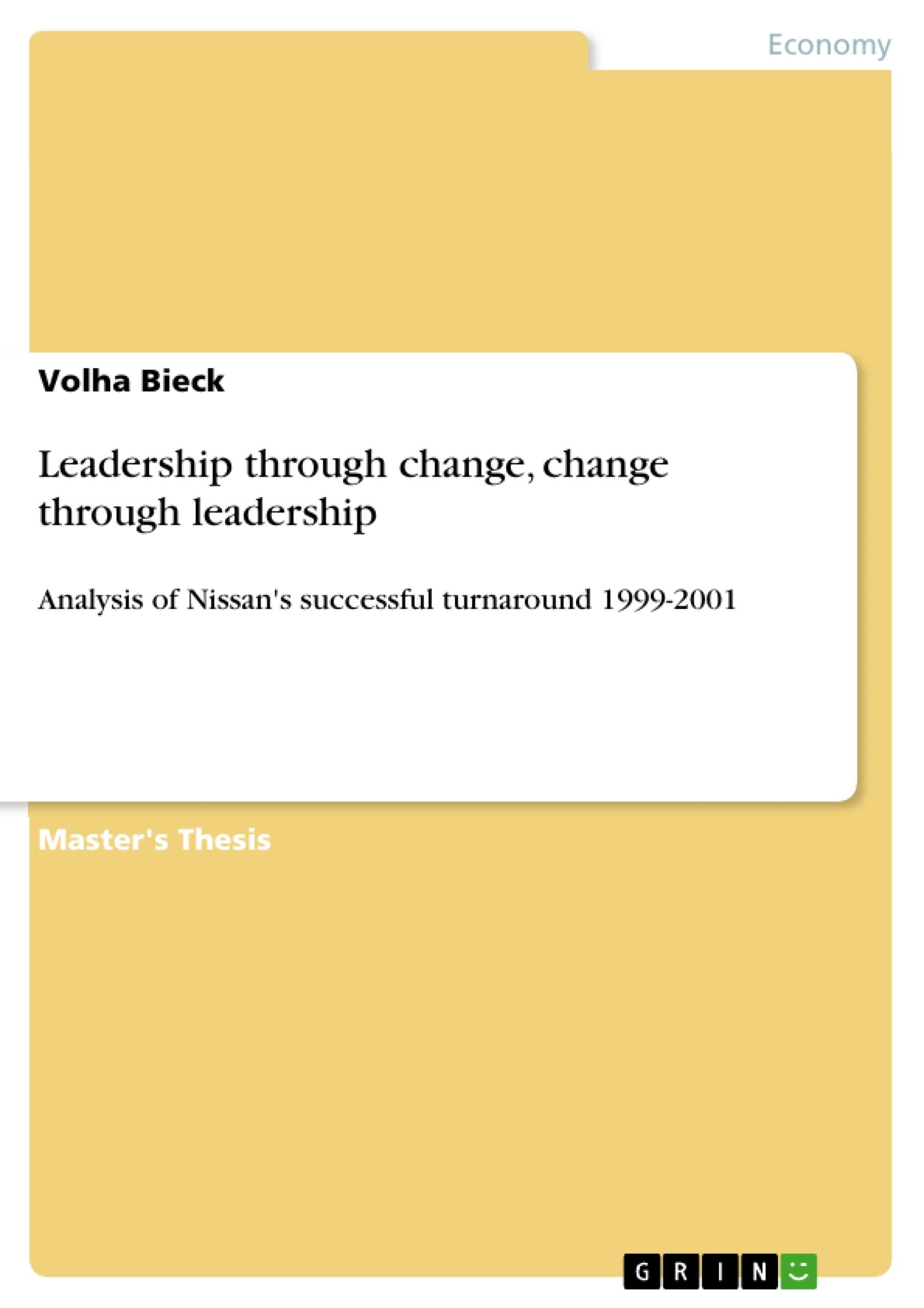In times of globalisation, more and more enterprises try to strengthen their market position through acquisition or alliance with new partners, so that the problem of uniting two companies and establishing a globally effective organisation gets on weight. Statistics on transformational change is not very positive though, only around 30 percent is reported to be successful. Nevertheless, some positive examples of the past and present show that transformational change indeed can succeed - if done correctly. What are the factors that define whether a change will succeed or fail?
The main objective of the thesis will be to analyse the success criteria of transformational change and the leader’s role in it on example of a Japanese car maker. Nissan’s turnaround in 1999 was initially criticised by industry insiders, but two years after the beginning of the transformation it was widely discussed in the international media and claimed as “sensational” because of its prompt and astonishing results. One man behind this change was Carlos Ghosn, who had a double function at that time as COO, both of Nissan and Renault, and could bring the heavy in-debt Japanese car maker into the black again.
Inhaltsverzeichnis (Table of Contents)
:- Objectives of the thesis
- Structure and methodology
- Research
- Leadership approaches
- Major characteristics of a leader
- Leadership styles and roles
- Goleman’s six leadership styles
- Situational leadership
- Transactional leadership
- Transformational leadership
- Reasons for strategic change
- Transactional change
- Transformational change
- Different levels of change in organisation
- Individual change: reasons for resistance
- Team change: the role of teams in a change management process
- Organisational change: organisation metaphors
- Three models of organisational change
- Change of organisational culture
- “New” approach for conducting organisational change
- Nissan’s U-turn: 1999-2001
- Overview of Nissan’s economic situation in 1999
- Carlos Ghosn: the European leader versus the Japanese tradition
- Different leadership styles implemented by Carlos Ghosn
- The U-turn of communication in Nissan
- Cultural U-turn of Nissan with Carlos Ghosn
- Leading change: the secret of Carlos Ghosn success as a leader
- Character
- Attributes
- Behaviours
- Emotions
- Competence
- Character
- Transformational change of Nissan according to 8 steps to New Organisation approach
Zielsetzung und Themenschwerpunkte (Objectives and Key Themes)
: The thesis aims to analyze the success criteria of transformational change and the leader’s role in it, using the example of Nissan's turnaround in 1999. By examining the factors that contributed to Nissan's successful revival, the thesis seeks to identify key aspects of effective leadership and change management. Here are the key themes explored in the text: * **Leadership and Change Management:** The role of leaders in successfully navigating organizational transformation. * **Cultural Transformation:** The challenges and strategies for adapting a company's culture to a new globalized environment. * **Cross-Functional Teams:** The importance of collaborative teamwork in achieving organizational change. * **Effective Communication:** The vital role of clear and consistent communication in driving organizational change. * **Organizational Structure and Culture:** The interrelationship between organizational structure, culture, and performance.Zusammenfassung der Kapitel (Chapter Summaries)
: The thesis begins by defining the objectives and methodology for its study of Nissan's transformation. It examines various leadership approaches, focusing on the importance of traits like emotional intelligence and conceptual skills. Chapter 2 delves into the different leadership styles and their impact on organizational change. It explores the transactional and transformational leadership approaches, with an emphasis on the latter's potential for significant change. Chapter 3 explores the reasons for strategic change, outlining the differences between transactional and transformational changes. It then moves into the various levels of change within an organization, covering individual resistance, team dynamics, and the different metaphors and models used to understand organizational change. Chapter 4 focuses on the practical application of change management models, including Lewin's Three-Step Model, Kotter's Eight Steps Model, and Kanter's Ten Commandments of Executing Change. It examines the importance of strong and adaptive cultures in ensuring organizational success. Chapter 5 analyzes the case of Nissan's turnaround, providing a detailed overview of the company's economic situation in 1999 and the arrival of Carlos Ghosn as a leader. It delves into Ghosn's leadership style, his communication strategies, and the cultural shift he implemented within Nissan. Chapter 5 concludes with a critical examination of Ghosn's leadership, highlighting his key characteristics and behaviors. It analyzes his approach to change management and the impact of his leadership on Nissan's overall success.Schlüsselwörter (Keywords)
: This work focuses on the concepts of **leadership, change management, transformational change, organizational culture, cross-functional teams, communication, and Nissan's turnaround**. It examines how effective leadership can drive significant change within a company, particularly in the context of a globalized business environment. The study uses real-world examples, such as the case of Nissan and its CEO Carlos Ghosn, to illustrate the key principles of successful change management.- Quote paper
- Volha Bieck (Author), 2013, Leadership through change, change through leadership, Munich, GRIN Verlag, https://www.grin.com/document/230044



